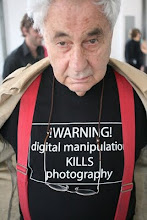Ruud van Empel
15 februari t/m 8 juni 2014
After a successful world tour, the work of artist Ruud van Empel is now to be exhibited for the first time in Brabant: thirty superb photographic works including four new ones from 2013 and an immense wall filling print featuring Van Empel's preliminary sketches. Eleven of the displayed photographic works have never previously been seen in the Netherlands.
Ruud van Empel (Breda 1958) is one of the most extraordinary artists of the moment. He composes spectacular digital photo collages using a technique he developed himself. We see people - often children - and landscapes in an aura of innocence and vulnerability. Beauty and identity are also important themes in his work. Van Empel's works seem like photos but with closer examination a feeling arises that there is more going on than meets the eye: unsurprisingly as these are self-constructed wonder worlds. He first makes pencil sketches of the scene he has in mind and then photographs models in his studio. Finally, at the computer - using hundreds of loose details and with the greatest precision - he designs a completely new picture. Details of the original models appear only as fragments.
Van Empels werk is mooi. Te mooi
Hij heeft bepaald niet te klagen over aandacht. De Bredase fotograaf Ruud van Empel (1958) viert de komende maanden met een overzicht in het Noordbrabants Museum in Den Bosch de afsluiting van een succesvolle internationale tournee. Zijn werk gaat als warme broodjes over de toonbank bij internationale galeries, veilinghuizen en op beurzen.
Van Empel is opgeleid als grafisch vormgever. In een tijd dat het modernistische principe van less is more in de kunst de toon aangeeft, ontwikkelt hij zich in tegenovergestelde richting: kitsch met een knipoog. Geen wonder dat hij zich als een vis in het water voelt als stilist bij de jeugdserie van Theo & Thea die tussen 1985 en 1989 heel Nederland aan de buis kluistert.
Maar de autonome kunst trekt, en vooral de digitale techniek die eind jaren tachtig in de kinderschoenen staat. Van Empels eerste schreden op dit pad worden gevormd door een nog steeds prachtige, aan surrealistische collages herinnerende serie The Office(vanaf 1995). In Den Bosch zijn twee ‘bureaus’ uit deze serie te zien: de ene, uit 2001, toont een man, verzwolgen door camera’s en lampen. De andere, uit hetzelfde jaar, toont een man, omgeven door eindeloze rijen van knopen in alle kleuren en maten. Beide mannen zijn gekleed in tot in de puntjes verzorgde kostuums. Beide foto’s zijn behalve mooi ook ademstokkend. De geënsceneerde schoonheid waarmee de mannen zijn omringd, is als een strop die steeds strakker wordt getrokken.
Die strop is sindsdien het uitgangspunt voor Van Empel. Het is zijn handelsmerk geworden, dat – zo blijkt op de tentoonstelling in Den Bosch – inmiddels behoorlijk wat slijtageplekken vertoont. In wisselende series als Moon, World, of Brothers and Sisters voert Van Empel een jeugdland ten tonele waar nimfachtige jongens en meisjes vaak in jarenvijftigkleding tussen groen struweel staan of liggen. Soms drijven ze in een vijver. Zowel de kleren als de kinderen zelf zijn onwerkelijk mooi en schoon. Geen pukkel ontsiert een wang, geen blauwe plek een blote arm. Dat kan ook niet anders, want alles – van wenkbrauw tot onderlip – komt uit de digitale plak- en knipdoos. Iedere gestalte is opgebouwd uit duizenden fragmenten van foto’s. Smelten we bij de aanblik van grote reeënogen? Dan neemt Van Empel de ogen van de één en plaatst die in het hoofd van de ander. Verdwijnen we in oceanisch blauwe irissen? Dan verandert Van Empel de kleur van de ogen van een jong meisje in ijl blauw, even blauw als het water van de vijver waarin het meisje zwemt.
De overduidelijke kunstmatigheid van de afbeelding veroorzaakt een licht schurend gevoel bij de kijker. Want natuurlijk weten we beter en is de kindertijd in werkelijkheid helemaal niet zo perfect. Nieuw is die notie niet – zeker niet in de kunst. Verontrustend is ze evenmin. Daarvoor zijn de fotowerken te esthetisch en is hun idioom te voor de hand liggend. Nee, als dit overzicht iets duidelijk maakt, dan is het dat Van Empel hard toe is aan een moedige stap het onbekende tegemoet.





























































